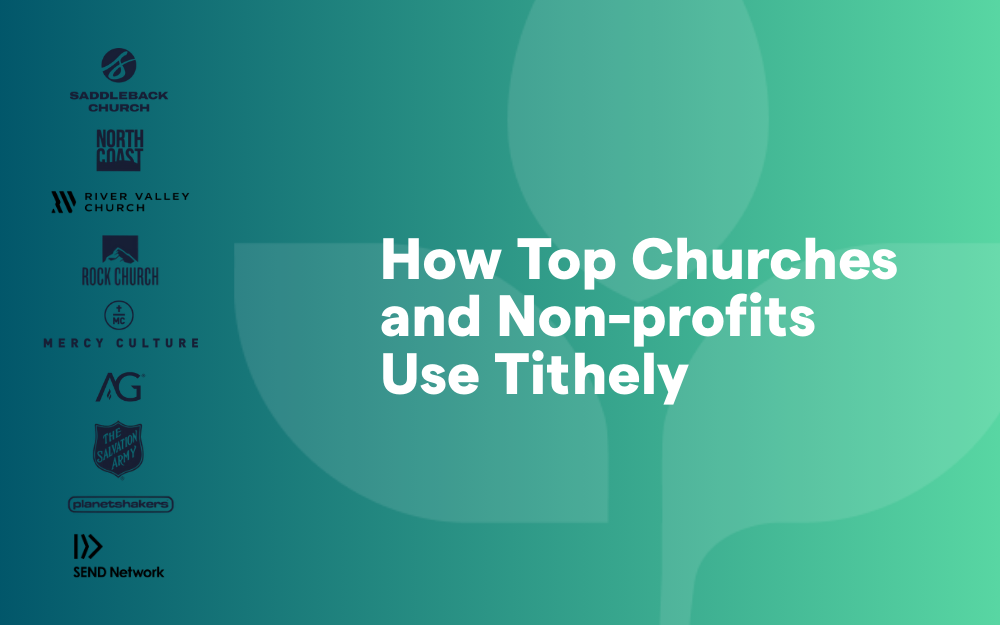Does Giving Decrease in a Recession?
As followers of Christ, we can set our hope in Jesus…not in a stable economy. But there is some good news in the midst of economic downturn. While it might seem like generosity towards nonprofits and churches may be headed for a dip, history shows us the opposite.

We’re headed into a recession in 2023–or at least, that’s what economists say.
Worldwide inflation, rising gas prices, skyrocketing mortgage rates in the U.S., and other economic woes have put financial pressure on people all over the planet. And though the employment rate has mostly recovered since the onset of the COVID-19 pandemic, a recent onslaught of layoffs in tech has created new stress for over 10 million people in this particular sector.
In short, things are looking grim.
Thankfully, as followers of Christ, we can set our hope in Jesus…not in a stable economy. But there is some good news in the midst of economic downturn. While it might seem like generosity towards nonprofits and churches may be headed for a dip, history shows us the opposite.
Giving doesn’t decrease in an economic downturn; in fact, in some cases, it increases.
A Short History of Giving
In the book of Ecclesiastes, Solomon said, “there is nothing new under the sun.” (Ecclesiastes 1:9b). History repeats itself. To answer the question of whether giving will decrease in a recession, we’ll look at the past several decades.
Generosity During the COVID-19 Pandemic
Let’s look at our most recent example of an economic crisis: the Coronavirus pandemic. In May 2020, the unemployment rate in the U.S. was a whopping 13%–up nearly 10% from February 2020. In three months, unemployment went higher than it did during the entire Great Recession of 2008-2009. Many people had trouble paying for their basic living expenses, as business owners and workers lost their jobs overnight. And yet, charitable giving reached a record $471 billion in 2020.
There are a few factors that explain this phenomenon. First, the majority of jobs lost during the pandemic were in industries that pay low wages. In other words, many middle to upper class families and individuals not only retained their jobs during the pandemic; they actually fared well financially. Between a lower cost of living and stimulus checks from the government, they were able to save more money…and give more money.
This is encouraging for a couple of reasons: First, people stepped up to the plate during a time of crisis. They were generous towards institutions that could serve people in need. Second, it shows an encouraging trend. When people have excess income–and many individuals will always have excess income–they give.
Generosity from 1979-present
Okay, let’s go back a bit further. Blackbaud Institute did a study on giving and the state of the economy from 1979 to 2021. And they found that giving has increased or stayed flat every single year over that three-decade period. In fact, adjusted for inflation, generosity has increased by over $300 billion.
What does all of this mean for churches? Expect people to be generous–even when things are financially tough.
How to Run an End of Year Giving Campaign in 2022
In the summer of 2022, 59% of donors to nonprofits said they were likely to give bigger gifts in 2022. Concerned about the state of nonprofits and their community, people want to give more generously to offset economic stress and burden.
If this is true outside of the Church, how much more should we expect our own church members to be radically generous?
An end of year giving campaign can help you boost generosity, even in a year that seems rattled by inflation and economic stress.
Here are three simple keys to running an end of year giving campaign.
- Use online giving.
Tithe.ly Giving can help you run a successful end of year giving campaign by providing the tools to make it simple to give online or by text message. In just a couple of clicks, church members can give on your website, church app, and even in a text message. Plus, you can create a special fund just for your end-of-year campaign–and even promote this special giving opportunity on your church homepage.
To learn more about Tithe.ly Giving, click here.
- Remind church members to give.
To run a successful year-end giving campaign, you need to do more than just set up your campaign online. You need to effectively market your campaign via email and text message, and at weekend church services.
Here are three tips to effectively promoting your campaign:
- Don’t be shy about asking church members to give. A culture of generosity will teach your church members that it is truly more blessed to give than to receive!
- Be strategic. A two-part email campaign reminds your church members to give, even during the week. Plus, you can link directly to your giving campaign page from your email (for examples of an email you can send, click here).
- Use text message. Most churches have caught on to using email to engage their congregation, but text messages are still underutilized as a form of communication. For your end-of-year campaign, try setting up a text message campaign with Tithe.ly and see how your response increases–especially from younger church members.
Reminding your church members to give several times is a key way to get a response. Remember that most people need several touchpoints with a call to action before saying “yes.”
- Give vision.
Give your church members the vision behind your end-of-year campaign. How will their financial contributions make an impact for the Kingdom of God?
Provide specific examples of how gifts that go above and beyond the tithe and offering can help build the Church and transform lives for Jesus. That might include paying for a food bank for the homeless; making much needed renovations to the church facility; or helping to run everyday operations that help your church thrive and succeed.
Generosity in a Recession
Can the Church be generous, even in a recession? You bet it can. Worldly circumstances don’t dictate our faith–only Jesus can do that. Here’s to a faith-filled season that sees another boost in generosity, blessings, and impact.
To take a deeper dive into building an end-of-year giving campaign, click here to download The Year-End Giving Playbook.
Sign Up for Product Updates
We’re headed into a recession in 2023–or at least, that’s what economists say.
Worldwide inflation, rising gas prices, skyrocketing mortgage rates in the U.S., and other economic woes have put financial pressure on people all over the planet. And though the employment rate has mostly recovered since the onset of the COVID-19 pandemic, a recent onslaught of layoffs in tech has created new stress for over 10 million people in this particular sector.
In short, things are looking grim.
Thankfully, as followers of Christ, we can set our hope in Jesus…not in a stable economy. But there is some good news in the midst of economic downturn. While it might seem like generosity towards nonprofits and churches may be headed for a dip, history shows us the opposite.
Giving doesn’t decrease in an economic downturn; in fact, in some cases, it increases.
A Short History of Giving
In the book of Ecclesiastes, Solomon said, “there is nothing new under the sun.” (Ecclesiastes 1:9b). History repeats itself. To answer the question of whether giving will decrease in a recession, we’ll look at the past several decades.
Generosity During the COVID-19 Pandemic
Let’s look at our most recent example of an economic crisis: the Coronavirus pandemic. In May 2020, the unemployment rate in the U.S. was a whopping 13%–up nearly 10% from February 2020. In three months, unemployment went higher than it did during the entire Great Recession of 2008-2009. Many people had trouble paying for their basic living expenses, as business owners and workers lost their jobs overnight. And yet, charitable giving reached a record $471 billion in 2020.
There are a few factors that explain this phenomenon. First, the majority of jobs lost during the pandemic were in industries that pay low wages. In other words, many middle to upper class families and individuals not only retained their jobs during the pandemic; they actually fared well financially. Between a lower cost of living and stimulus checks from the government, they were able to save more money…and give more money.
This is encouraging for a couple of reasons: First, people stepped up to the plate during a time of crisis. They were generous towards institutions that could serve people in need. Second, it shows an encouraging trend. When people have excess income–and many individuals will always have excess income–they give.
Generosity from 1979-present
Okay, let’s go back a bit further. Blackbaud Institute did a study on giving and the state of the economy from 1979 to 2021. And they found that giving has increased or stayed flat every single year over that three-decade period. In fact, adjusted for inflation, generosity has increased by over $300 billion.
What does all of this mean for churches? Expect people to be generous–even when things are financially tough.
How to Run an End of Year Giving Campaign in 2022
In the summer of 2022, 59% of donors to nonprofits said they were likely to give bigger gifts in 2022. Concerned about the state of nonprofits and their community, people want to give more generously to offset economic stress and burden.
If this is true outside of the Church, how much more should we expect our own church members to be radically generous?
An end of year giving campaign can help you boost generosity, even in a year that seems rattled by inflation and economic stress.
Here are three simple keys to running an end of year giving campaign.
- Use online giving.
Tithe.ly Giving can help you run a successful end of year giving campaign by providing the tools to make it simple to give online or by text message. In just a couple of clicks, church members can give on your website, church app, and even in a text message. Plus, you can create a special fund just for your end-of-year campaign–and even promote this special giving opportunity on your church homepage.
To learn more about Tithe.ly Giving, click here.
- Remind church members to give.
To run a successful year-end giving campaign, you need to do more than just set up your campaign online. You need to effectively market your campaign via email and text message, and at weekend church services.
Here are three tips to effectively promoting your campaign:
- Don’t be shy about asking church members to give. A culture of generosity will teach your church members that it is truly more blessed to give than to receive!
- Be strategic. A two-part email campaign reminds your church members to give, even during the week. Plus, you can link directly to your giving campaign page from your email (for examples of an email you can send, click here).
- Use text message. Most churches have caught on to using email to engage their congregation, but text messages are still underutilized as a form of communication. For your end-of-year campaign, try setting up a text message campaign with Tithe.ly and see how your response increases–especially from younger church members.
Reminding your church members to give several times is a key way to get a response. Remember that most people need several touchpoints with a call to action before saying “yes.”
- Give vision.
Give your church members the vision behind your end-of-year campaign. How will their financial contributions make an impact for the Kingdom of God?
Provide specific examples of how gifts that go above and beyond the tithe and offering can help build the Church and transform lives for Jesus. That might include paying for a food bank for the homeless; making much needed renovations to the church facility; or helping to run everyday operations that help your church thrive and succeed.
Generosity in a Recession
Can the Church be generous, even in a recession? You bet it can. Worldly circumstances don’t dictate our faith–only Jesus can do that. Here’s to a faith-filled season that sees another boost in generosity, blessings, and impact.
To take a deeper dive into building an end-of-year giving campaign, click here to download The Year-End Giving Playbook.
podcast transcript
We’re headed into a recession in 2023–or at least, that’s what economists say.
Worldwide inflation, rising gas prices, skyrocketing mortgage rates in the U.S., and other economic woes have put financial pressure on people all over the planet. And though the employment rate has mostly recovered since the onset of the COVID-19 pandemic, a recent onslaught of layoffs in tech has created new stress for over 10 million people in this particular sector.
In short, things are looking grim.
Thankfully, as followers of Christ, we can set our hope in Jesus…not in a stable economy. But there is some good news in the midst of economic downturn. While it might seem like generosity towards nonprofits and churches may be headed for a dip, history shows us the opposite.
Giving doesn’t decrease in an economic downturn; in fact, in some cases, it increases.
A Short History of Giving
In the book of Ecclesiastes, Solomon said, “there is nothing new under the sun.” (Ecclesiastes 1:9b). History repeats itself. To answer the question of whether giving will decrease in a recession, we’ll look at the past several decades.
Generosity During the COVID-19 Pandemic
Let’s look at our most recent example of an economic crisis: the Coronavirus pandemic. In May 2020, the unemployment rate in the U.S. was a whopping 13%–up nearly 10% from February 2020. In three months, unemployment went higher than it did during the entire Great Recession of 2008-2009. Many people had trouble paying for their basic living expenses, as business owners and workers lost their jobs overnight. And yet, charitable giving reached a record $471 billion in 2020.
There are a few factors that explain this phenomenon. First, the majority of jobs lost during the pandemic were in industries that pay low wages. In other words, many middle to upper class families and individuals not only retained their jobs during the pandemic; they actually fared well financially. Between a lower cost of living and stimulus checks from the government, they were able to save more money…and give more money.
This is encouraging for a couple of reasons: First, people stepped up to the plate during a time of crisis. They were generous towards institutions that could serve people in need. Second, it shows an encouraging trend. When people have excess income–and many individuals will always have excess income–they give.
Generosity from 1979-present
Okay, let’s go back a bit further. Blackbaud Institute did a study on giving and the state of the economy from 1979 to 2021. And they found that giving has increased or stayed flat every single year over that three-decade period. In fact, adjusted for inflation, generosity has increased by over $300 billion.
What does all of this mean for churches? Expect people to be generous–even when things are financially tough.
How to Run an End of Year Giving Campaign in 2022
In the summer of 2022, 59% of donors to nonprofits said they were likely to give bigger gifts in 2022. Concerned about the state of nonprofits and their community, people want to give more generously to offset economic stress and burden.
If this is true outside of the Church, how much more should we expect our own church members to be radically generous?
An end of year giving campaign can help you boost generosity, even in a year that seems rattled by inflation and economic stress.
Here are three simple keys to running an end of year giving campaign.
- Use online giving.
Tithe.ly Giving can help you run a successful end of year giving campaign by providing the tools to make it simple to give online or by text message. In just a couple of clicks, church members can give on your website, church app, and even in a text message. Plus, you can create a special fund just for your end-of-year campaign–and even promote this special giving opportunity on your church homepage.
To learn more about Tithe.ly Giving, click here.
- Remind church members to give.
To run a successful year-end giving campaign, you need to do more than just set up your campaign online. You need to effectively market your campaign via email and text message, and at weekend church services.
Here are three tips to effectively promoting your campaign:
- Don’t be shy about asking church members to give. A culture of generosity will teach your church members that it is truly more blessed to give than to receive!
- Be strategic. A two-part email campaign reminds your church members to give, even during the week. Plus, you can link directly to your giving campaign page from your email (for examples of an email you can send, click here).
- Use text message. Most churches have caught on to using email to engage their congregation, but text messages are still underutilized as a form of communication. For your end-of-year campaign, try setting up a text message campaign with Tithe.ly and see how your response increases–especially from younger church members.
Reminding your church members to give several times is a key way to get a response. Remember that most people need several touchpoints with a call to action before saying “yes.”
- Give vision.
Give your church members the vision behind your end-of-year campaign. How will their financial contributions make an impact for the Kingdom of God?
Provide specific examples of how gifts that go above and beyond the tithe and offering can help build the Church and transform lives for Jesus. That might include paying for a food bank for the homeless; making much needed renovations to the church facility; or helping to run everyday operations that help your church thrive and succeed.
Generosity in a Recession
Can the Church be generous, even in a recession? You bet it can. Worldly circumstances don’t dictate our faith–only Jesus can do that. Here’s to a faith-filled season that sees another boost in generosity, blessings, and impact.
To take a deeper dive into building an end-of-year giving campaign, click here to download The Year-End Giving Playbook.
VIDEO transcript
We’re headed into a recession in 2023–or at least, that’s what economists say.
Worldwide inflation, rising gas prices, skyrocketing mortgage rates in the U.S., and other economic woes have put financial pressure on people all over the planet. And though the employment rate has mostly recovered since the onset of the COVID-19 pandemic, a recent onslaught of layoffs in tech has created new stress for over 10 million people in this particular sector.
In short, things are looking grim.
Thankfully, as followers of Christ, we can set our hope in Jesus…not in a stable economy. But there is some good news in the midst of economic downturn. While it might seem like generosity towards nonprofits and churches may be headed for a dip, history shows us the opposite.
Giving doesn’t decrease in an economic downturn; in fact, in some cases, it increases.
A Short History of Giving
In the book of Ecclesiastes, Solomon said, “there is nothing new under the sun.” (Ecclesiastes 1:9b). History repeats itself. To answer the question of whether giving will decrease in a recession, we’ll look at the past several decades.
Generosity During the COVID-19 Pandemic
Let’s look at our most recent example of an economic crisis: the Coronavirus pandemic. In May 2020, the unemployment rate in the U.S. was a whopping 13%–up nearly 10% from February 2020. In three months, unemployment went higher than it did during the entire Great Recession of 2008-2009. Many people had trouble paying for their basic living expenses, as business owners and workers lost their jobs overnight. And yet, charitable giving reached a record $471 billion in 2020.
There are a few factors that explain this phenomenon. First, the majority of jobs lost during the pandemic were in industries that pay low wages. In other words, many middle to upper class families and individuals not only retained their jobs during the pandemic; they actually fared well financially. Between a lower cost of living and stimulus checks from the government, they were able to save more money…and give more money.
This is encouraging for a couple of reasons: First, people stepped up to the plate during a time of crisis. They were generous towards institutions that could serve people in need. Second, it shows an encouraging trend. When people have excess income–and many individuals will always have excess income–they give.
Generosity from 1979-present
Okay, let’s go back a bit further. Blackbaud Institute did a study on giving and the state of the economy from 1979 to 2021. And they found that giving has increased or stayed flat every single year over that three-decade period. In fact, adjusted for inflation, generosity has increased by over $300 billion.
What does all of this mean for churches? Expect people to be generous–even when things are financially tough.
How to Run an End of Year Giving Campaign in 2022
In the summer of 2022, 59% of donors to nonprofits said they were likely to give bigger gifts in 2022. Concerned about the state of nonprofits and their community, people want to give more generously to offset economic stress and burden.
If this is true outside of the Church, how much more should we expect our own church members to be radically generous?
An end of year giving campaign can help you boost generosity, even in a year that seems rattled by inflation and economic stress.
Here are three simple keys to running an end of year giving campaign.
- Use online giving.
Tithe.ly Giving can help you run a successful end of year giving campaign by providing the tools to make it simple to give online or by text message. In just a couple of clicks, church members can give on your website, church app, and even in a text message. Plus, you can create a special fund just for your end-of-year campaign–and even promote this special giving opportunity on your church homepage.
To learn more about Tithe.ly Giving, click here.
- Remind church members to give.
To run a successful year-end giving campaign, you need to do more than just set up your campaign online. You need to effectively market your campaign via email and text message, and at weekend church services.
Here are three tips to effectively promoting your campaign:
- Don’t be shy about asking church members to give. A culture of generosity will teach your church members that it is truly more blessed to give than to receive!
- Be strategic. A two-part email campaign reminds your church members to give, even during the week. Plus, you can link directly to your giving campaign page from your email (for examples of an email you can send, click here).
- Use text message. Most churches have caught on to using email to engage their congregation, but text messages are still underutilized as a form of communication. For your end-of-year campaign, try setting up a text message campaign with Tithe.ly and see how your response increases–especially from younger church members.
Reminding your church members to give several times is a key way to get a response. Remember that most people need several touchpoints with a call to action before saying “yes.”
- Give vision.
Give your church members the vision behind your end-of-year campaign. How will their financial contributions make an impact for the Kingdom of God?
Provide specific examples of how gifts that go above and beyond the tithe and offering can help build the Church and transform lives for Jesus. That might include paying for a food bank for the homeless; making much needed renovations to the church facility; or helping to run everyday operations that help your church thrive and succeed.
Generosity in a Recession
Can the Church be generous, even in a recession? You bet it can. Worldly circumstances don’t dictate our faith–only Jesus can do that. Here’s to a faith-filled season that sees another boost in generosity, blessings, and impact.
To take a deeper dive into building an end-of-year giving campaign, click here to download The Year-End Giving Playbook.




























